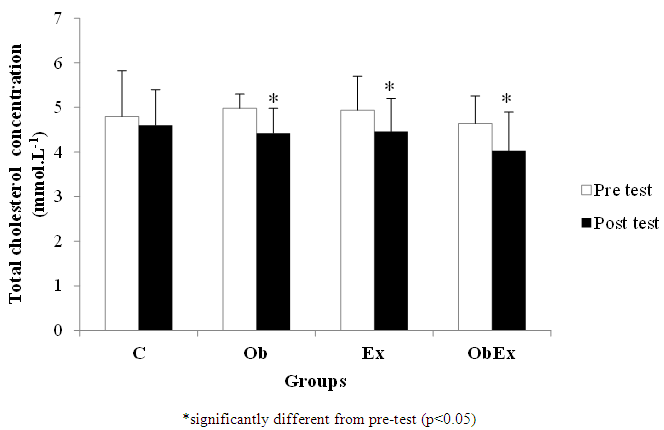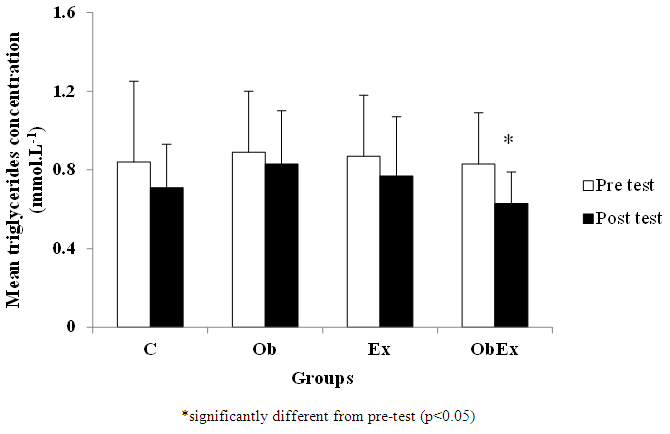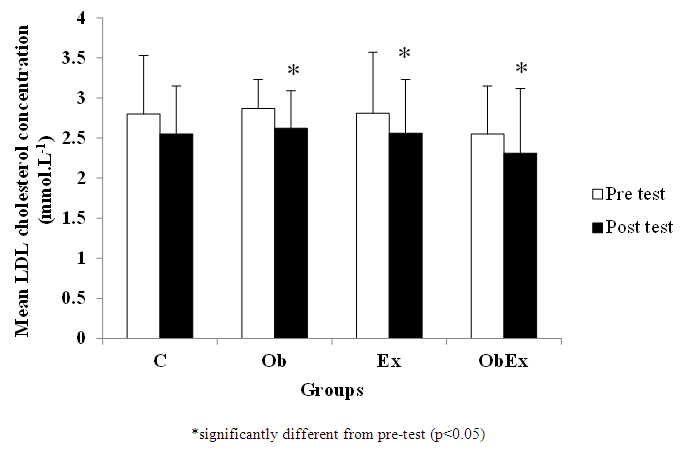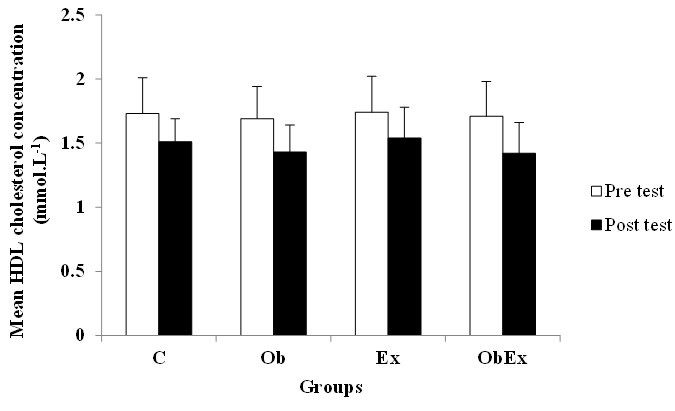-
Paper Information
- Paper Submission
-
Journal Information
- About This Journal
- Editorial Board
- Current Issue
- Archive
- Author Guidelines
- Contact Us
International Journal of Sports Science
p-ISSN: 2169-8759 e-ISSN: 2169-8791
2016; 6(5): 169-175
doi:10.5923/j.sports.20160605.01

Combined Effects of Oat Bran Supplementation and Jogging Exercise on Body Composition and Blood Lipid Profiles in Young Female
Foong Kiew Ooi1, Hamzah Muhammad Alif Ridzuan2
1Sports Science Unit, School of Medical Sciences, Universiti Sains Malaysia, Kubang Kerian, Malaysia
2School of Health Sciences, Universiti Sains Malaysia, Kubang Kerian, Malaysia
Correspondence to: Foong Kiew Ooi, Sports Science Unit, School of Medical Sciences, Universiti Sains Malaysia, Kubang Kerian, Malaysia.
| Email: |  |
Copyright © 2016 Scientific & Academic Publishing. All Rights Reserved.
This work is licensed under the Creative Commons Attribution International License (CC BY).
http://creativecommons.org/licenses/by/4.0/

Introduction: To date, information on the additional effect of combined oat bran supplementation and exercise on body composition and lipid profiles is still lacking. Objective: To investigate the effectiveness of combined oat bran supplementation and jogging exercise compared to oat bran supplementation alone or jogging exercise alone on body composition and lipid profiles in young females. Methods: Forty eight female university students were divided into 4 groups: control (C), oat bran supplementation alone (Ob), Exercise alone (Ex) and combined oat bran and exercise (ObEx) groups. Participants in Ob and ObEx groups consumed oat bran 7 days per week for 6 weeks. Participants in Ex and ObEx groups carried out jogging exercise 3 days per week for 6 weeks. Results: There were no significant changes in percentage body fat and fat free mass in all groups. Significant reductions in TC (-13.57%), TG (-20.65%) and LDL-C (-10.77%) were observed in ObEx group. In Ob group, there were significant reduction in TC (-11.42%) and LDL-C (-9.16%). Similarly, significant reductions in TC (-9.43%) and LDL-C (-8.0%) were also observed in Ex group. Conclusions: Combination of oat bran supplementation and jogging exercise significantly reduced level of total cholesterol, triglyceride and low density lipoprotein cholesterol, however did not affect high density lipoprotein cholesterol level. In general, the combination of oat bran and jogging exercise elicited more beneficial effects on blood lipid profiles compared to control, oat bran supplementation alone and exercise alone groups. Therefore, this combination can be recommended for improving lipid profiles in young female population.
Keywords: Body composition, Exercise, Lipid profiles, Oat Bran
Cite this paper: Foong Kiew Ooi, Hamzah Muhammad Alif Ridzuan, Combined Effects of Oat Bran Supplementation and Jogging Exercise on Body Composition and Blood Lipid Profiles in Young Female, International Journal of Sports Science, Vol. 6 No. 5, 2016, pp. 169-175. doi: 10.5923/j.sports.20160605.01.
Article Outline
1. Introduction
- Components of blood lipid profile include total cholesterol (TC), triglycerides (TG), low-density lipoprotein cholesterol (LDL-C) and high-density lipoprotein cholesterol (HDL-C). LDL-C contains 25% proteins, 5% triglycerides, 20% phospholipids, and 50% cholesterol. LDL-C deposits in and around smooth muscle fibers in arteries. When LDL-C presents in excessive numbers, it can form fatty plaques that increase the risk of coronary artery disease. It is also known as bad cholesterol. [1] HDL-C which contains 40-45% proteins, 5-10% triglycerides, 30% phospholipids, and 20% cholesterol, can remove excess cholesterol from blood cells, and transport it to liver for elimination. It can prevent accumulation of the fatty plaques. High level of HDL-C is associated with decreased risk of coronary artery disease and known as good cholesterol. [1]In year 1997, The US Food and Drug Administration (FDA), which assesses health claims for foods, has approved health claims for the viscous fibers oat β-glucan as cholesterol-lowering agent, and it can reduce the risk of cardiovascular disease. Additionally, the FDA has passed a rulling that allowed oat bran to be registered as the first cholesterol-reducing food at an amount of 3 grams beta-glucan daily. [2]In year 2010, the Panel on Dietetic Products, Nutrition and Allergies of the European Food Safety Authority also had issued an opinion that there is a scientific substantiation of a health claim related to oat beta-glucan and lowering of blood LDL and total cholesterol. They mentioned that a lowering blood LDL-cholesterol concentration is a beneficial physiological effect by decreasing the risk of coronary heart disease. The effects of oat beta-glucan at doses of at least 3 grams per day have shown a decrease in LDL-cholesterol concentrations. The Panel also mentioned that a cause and effect relationship has been established between the consumption of oat beta-glucan and lowering of blood LDL-cholesterol concentrations. The Panel also considered that foods should provide at least 3 g of oat beta-glucan per day. This amount can reasonably be consumed as part of a balanced diet in adults who want to lower their blood cholesterol concentrations. [3]To date, it is known that one of the cholesterol reduction supplements is Biogrow Oat BG22TMoat bran powder with 20% of beta glucan. It contains carbohydrate, dietary fiber, protein, fat, magnesium, iron, zinc and sodium. The recommended doses for an individual are 2 scoops (18gram) per day, which can provide 3.6 gram of beta glucan. [4]Oat bran is a part of oat, and Avena sativa is the scientific name. When the oats arrive from the farm, one of the first jobs after cleaning is to remove the outer husk of the oat. The part of the oat left after this 'shelling' process is the 'groat'. The outer layer of the groat contains bran. The groat with bran is called oat bran. Oat bran consists of beta glucan which can reduce low-density lipoprotein cholesterol (LDL-C). [5, 6] Wolever et al. [7] reported that consumption of a minimum of 3 gram high molecular weight oat beta glucan per day can reduce cardiovascular disease (CVD) risk by up to 12%. They also reported that consumption of at least 2 servings of oat beta-glucan per day for 4 weeks demonstrated a 5.5% average decrease in LDL-C level. This is beneficial for human health since 1% reduction in LDL-C reduces CVD risk by 2%. According to American College of Sports Medicine/ACSM’s guidelines for exercise testing and prescription (2010), exercises can be divided into three main types, i.e. aerobic or cardiovascular endurance exercise, resistance exercise for muscular fitness and flexibility exercise. The exercise recommendation framework for frequency and time of exercise and type of exercise for sedentary healthy adults are 3 to 5 days per week, 20 to 30 minutes per day or 60 to 150 min per week, with walking, jogging, stepping and cycling exercise. [8]Body composition includes body fat and lean (fat free) body mass. It is known that exercise can improve body composition by decreasing percentage of body fat and increasing lean body mass. [9, 10] Meanwhile, Trejo-Gutierrez & Flercher [11] mentioned that regular exercise can also decrease one’s lipid profiles such as total cholesterol (TC), low density lipoprotein cholesterol (LDL-C), and triglycerides (TG), and increase high density lipoprotein cholesterol (HDL-C).Several previous studies also have shown evidences that exercise can elicit positive effects on lipid profiles. [12-14]Since to date, the information of the additional beneficial effects of combined oat bran and jogging exercise compared to oat bran supplementation alone or jogging exercise alone on body composition and blood lipid profiles in young females are lacking, therefore the present study was proposed.
2. Methods
2.1. Participants
- Forty eight sedentary female were recruited in the present study. The inclusion criteria of participants were healthy volunteers who were free from any healthy problem, non-smokers, young females university student with age between 19-25 years old, did not engage with any training program or did not exercise more than once per week, and also did not have the habit of consuming oat bran. The participants were required to answer questionnaires to ensure their eligibility. The qualified participants were matched in age, body weight, height and percent of body fat before they were randomly assigned into the experimental groups. The participants were divided into four groups, i.e. control group (C), oat bran supplementation alone group (Ob), exercise alone group (Ex) and combined oat bran supplementation with exercise group (ObEx). The whole experimental period was 6 weeks. Pre- and post test were performed before and after 6 weeks of experimental period.
2.2. Experimental Design
2.2.1. Anthropometric Characteristic, Body Composition and Resting Heart Rate Measurements
- In this study, anthropometric parameters such as body weight and body composition i.e percentage of body fat and lean body mass were measured during pre- and post tests. Body composition and body weight were measured by using Tanita Body Composition Analyzer (model TBF-410). A stadiometer (Seca 220, Germany) was used to measure the body height at pre test.
2.2.2. Blood Lipid Profiles Measurement
- Approximately 5 ml of resting venous blood sample was collected during each sample collection during pre-and post-tests. Participants were required to fast overnight from 12 a.m. (mid night) before fasting blood sample taking in the morning (8 a.m.). After blood sample taking, blood samples were analyzed for serum total cholesterol (TC), serum total triglycerides (TG), low-density lipoprotein cholesterol (LDL-C), and high-density lipoprotein cholesterol (HDL-C). The procedures were handled by Sport Science Laboratory technologists of Universiti Sains Malaysia. For blood analysis, Cholesterol CHOP-PAP method was used to analyze TC concentration. TG was determined with glycerol phosphate oxidase followed by a POD catalyzed indicator reaction, and HDL-C was determined after LDL-C was precipated by phosphotungstic acid with the presence of magnesium ion. The acceptable range of TC, TG, LDL-C, and HDL-C was 3.6-6.2 mmol.L-1, 0.68-1.88 mmol.L-1, less than 4.1 mmol.L-1 and 0.78-1.88 mmol.L-1 respectively.
2.2.3. Oat Bran Supplementation
- The participants in both oat bran supplementation alone (Ob) and combined exercise with oat bran supplementation group (ObEx) groups consumed oat bran supplementation with 2 scoops of Oat bran powder BG22TM, i.e. 18g of oat bran powder containing 3.6 grams of beta glucan, diluted with plain water every day for 6 weeks. The participants were required to consume 1 scoopful of Oat bran powder which was mixed with 250 ml of water before breakfast, and another 1 scoopful of Oat bran powder which was mixed with 250 ml of water before lunch or dinner. On the exercised days, the participants in ObEx group were required to consume oat bran one hour before jogging on exercise days.
2.2.4. Jogging Exercise Program
- Participants in the exercise without oat supplementation group (Ex alone) and exercise with oat supplementation group (ObEx) were required to perform jogging exercise program for 6 weeks. In the 6 weeks of exercise period, the participants were required to jog 3 times per week in the evening. Five minutes of warming up activities were carried out before 30 minutes of jogging exercise, after performing 30 minutes of jogging exercise with moderate intensity, i.e. 55% to 70% of the participant individual’s age-predicted heart rate maximum (HRmax), 5 minutes of cooling down activities were carried out. The intensity of jogging exercise was measured by using heart rate monitor (Polar, S710, USA) worn by participants throughout the jogging sessions. Post-exercise heart rate of the participants was determined immediately after each jogging session. The exercise program was carried out under the supervision of the researcher in Health Campus of Universiti Sains Malaysia.
2.2.5. Statistical Analysis
- Statistical analysis was done by using Statistical Package for Social Science (SPSS) version 21.0. All values are presented as mean±standard deviation (SD). Repeated measure Analysis of variance (ANOVA) and Bonferroni post hoc test were performed to determine the significance of the differences between and within groups. Comparisons were adjusted by Bonferroni correction. The difference was considered statistically significant at p<0.05. Confounding variables such as participants’ age, body mass, height and body fat were considered before the commencement of the study. The participants were matched in age, body weight, height and percent of body fat before they were randomly assigned into the experimental groups. One-way analysis of variance (ANOVA) was performed to ensure that there were no significant differences in the aforementioned confounding variables among the groups at the beginning of the study.
3. Results
3.1. Anthropometric Characteristic and Body Composition
- Forty eight participants with mean age of 20±1.3 years old completed this study. The mean body height of the participants in C, Ob, Ex and ObEx was 156.5±6.11, 156.83±5.84, 153.75±4.07 and 153.83±6.49 respectively. The study results of body weight, percentage of body fat and fat free mass are illustrated in Table 1. After 6 weeks of intervention period, there were no significant simple effects of intervention on body weight, percentage of body fat and fat free mass (p>0.05) between all the experimental groups. Similarly, no significant main effect of time on these parameters (p>0.05) between pre- and post tests for all experimental groups.
|
3.2. Blood Lipid Profiles
3.2.1. Total Cholesterol (TC) Concentrations
- The TC concentrations of each group are presented in Figure 1. There were no significant simple effect of intervention on TC concentrations between all the experimental groups after 6 weeks of intervention period. However, there were statistically significant main effect of time on this parameter between pre- and post tests in Ob, Ex and ObEx groups. After 6 weeks of study period, the concentration of total cholesterol significantly reduced in Ob (p=0.001), Ex (p=0.011) and ObEx (p=0.001). The combined oat bran and exercise group (ObEx) showed the highest percentage of reduction (-13.57%) followed by oat bran group (-11.42%), exercise group (-9.43%) and control group (-8.88%).
 | Figure 1. Mean total cholesterol concentration at pre- and post tests |
3.2.2. Triglycerides (TG) Concentrations
- The mean TG concentrations of all groups are shown in Figure 2. There were no significant simple effect of intervention on TG concentration between all the experimental groups after 6 weeks of intervention period. There were statistical significant main effect of time between pre- and post tests for ObEx group with a significant reduction effect (20.65%, p=0.03) after 6 weeks of study period compared to pre test. However, there were no significant differences in TG between pre- and post test in C, Ob and Ex groups.
 | Figure 2. Mean triglycerides concentration at pre- and post tests |
3.2.3. Low Density Lipoprotein Cholesterol (LDL-C) Concentrations
- Mean LDL-C concentrations at pre- and post tests are presented in Figure 3. There were no significant simple effect of intervention on LDL-C concentration between all the groups after 6 weeks of intervention period, the values of LDL-C were not significantly different among all the groups. Significant main effect of time was observed in Ob, Ex and ObEx groups, with significant reduction effect in LDL-C in Ob (p=0.003), Ex (p=0.045) and ObEx (p=0.027) groups at post test compared to pre test. The present study results showed that the mean percentage reduction in combined oat bran and exercise group (ObEx) was the highest (-10.77%), followed by oat bran group (-9.16%), exercise group (-8.00%) and control group (-6.11%).
 | Figure 3. Mean low density lipoprotein cholesterol (LDL) concentration at pre-and post tests |
3.2.4. High Density Lipoprotein Cholesterol (HDL-C) con Centrations
- Mean concentrations of HDL-C of all the groups are presented in Figure 4. There were no significant simple effect of intervention HDL-C concentration between all the groups after 6 weeks of intervention period. Similarly, there were no significant main effect of time between pre-and post tests in all the groups. The present study results showed that the greatest decrement was in combined oat bran and exercise group (ObEx) with -16.29% of percentage reduction, followed by Ob group (-14.56%), Ex group (-11.24%) and control group (-11.12%).
 | Figure 4. Mean high density lipoprotein cholesterol (HDL) concentration at pre- and post tests |
4. Discussion
- The main objective of the present study was to investigate the additional beneficial effects of combined oat bran and jogging exercise compared to oat bran supplementation alone or jogging exercise alone on body composition and blood lipid profiles in young females. In the present study, it was found that there were no significantly differences in percentage body fat and fat free mass in all the groups at pre- and post tests. Similarly, there were no significant changes in these two body composition parameters after 6 weeks of study period. These findings imply that Ob alone, Ex alone and combined ObEx did not affect body composition of the participant. Excess of body fat can cause obesity and also can increase an individual's risk of morbidity from hypertension, dyslipidemia, type 2 diabetes mellitus, coronary heart disease, stroke, gallbladder disease, osteoarthritis, and certain types of cancers. [15] In the present study, jogging exercise, oat bran and its combination did not affect body fat. In a previous study carried out by Brian et al. [16], it was found that 16 weeks of aerobic exercise was effective in reducing body fat. Exercise duration is a factor to reduce body fat. It was speculated that the duration of 6 weeks study period in the present study may not be long enough to reduce body fat of the participants. Thus, duration of exercise may be needed to be modified in future studies for the purpose of reducing fat. In the present study, participants’ average heart rates recorded at post exercise were ranging from 110 to 154 beats.min-1, which was equivalent to 55% to 70% of the participants’ maximum heart rate, reflecting that the intensity of the prescribed exercise in the present study was considered moderate. Collectively, findings of the present study imply that jogging exercise with moderate intensity performed at 3 times per week for 6 weeks was not able to reduce body fat of the participants. The main findings of the present study was that combination of oat bran supplement and jogging exercise was most effective in improving blood lipid profiles of the participants. The present study showed that combination of oat bran supplementation and jogging exercise had decreased TC (p=0.001), TG (p=0.03), LDL-C (p=0.027) after 6 weeks of intervention period in ObEx group. Nevertheless, this combination did not affect HDL-C. Similarly, Marcia et al. [17] also reported that Cholesterol Education Program (NCEP) step 2 diet plus aerobic exercise showed an excellent effect by significantly decrease TC and LDL-C, even though there was no positive effects on HDL-C in men and postmenopausal women with high levels of LDL-C and low levels of HDL-C.It is known that increment of HDL-C can reduce atherosclerosis in coronary disease patients. [18] In study by Alison et al. [19], it was found that HDL-C significantly increased after 6 weeks of intervention with fish oil and sunflower oil with aerobic exercise and its level increased until week 12th. In contrast to the findings of Alison et al. [19], there were no changes in HDL-C in the present study. It was speculated that tuna fish oil and sunflower oil maybe are effective to increase HDL-C level compared to oat bran that was consumed by the participants in the present study. Besides that, study of Alison et al. [19] was on overweight and high blood pressure participants, whereas healthy female university student participants were recruited in the present study. Therefore, it was speculated that the health condition of the participants can be a factor in affecting the results of the studies. Improvement of blood lipid profiles could be obtained through involvement in exercise program such as endurance training, [20] multicomponent training [21] and concurrent training with combination of endurance training and resistance training. [22] In the present study, it was shown that aerobic exercise can improve blood lipid profiles too, particularly in TC (p=0.011) and LDL-C (p=0.045). In another study by Edgar et al. [23] with aerobic exercise performed by the participants 3 times per week for 9 weeks, it was found that TC, TG and LDL-C levels decreased at the end of the study period. However in our study, 6 weeks of aerobic exercise was able to decrease TC and LDL-C significantly but not TG. In the present study, participants performed 6 weeks of exercise but not 9 weeks as in Edgar et al. [23]. It is speculated that may be longer duration of exercise period is needs for increasing TG in the participants of the present study. Joana et al. [21] (2009) found that multicomponent exercise program with resistance training did not affect TC and LDL-C in older women. It was speculated that the weakness of study of Joana et al. [21] (2009) was with the procedure of exercise. In their study, the participants carried out the multicomponent exercise independently. Whereas, in our study, our participants who involved in exercise program and supplementation were monitored by the researcher. Besides that, age of the participants may have affected the outcome of blood lipid profiles, in which older women were recruited in study of Joana et al. [21], and young females were recruited in the present study.In the present study, supplementation of oat bran powder showed its potential in reducing the participants’ TC (p=0.01) and LDL-C (p=0.03) level, but it did not affect HDL-C. It was mentioned by Biorklund et al. [5] and Queenam et al. [6] that oat bran can reduce blood lipid profiles, and beta-glucan that exist in oat bran enable to reduce TC and LDL-C.The present study findings are agreement with their statements. In a study by Kjeld et al. [24], soy-based dietary supplement was consumed by Type 2 Diabetic participants, it was found that TG and LDL-C decreased significantly, the decrease was not significant in TC concentration level, and HDL-C level was not affected. In Jo et al. [25], it was found that there was significant effect of soy protein on HDL-C in hypercholesterolemic postmenopausal women. Similarly, Susan et al. [26] also reported that soy protein and isoflavones could increase HDL-C level in postmenopausal women. We speculated that protein contained in soy has potential in increasing HDL-C level compared to oat bran which may not contain high level of protein as soy. Thus, oat bran can decrease TC, TG and LDL-C level while soy can increase the HDL-C level.
5. Conclusions
- The present study found that oat bran supplementation alone and jogging exercise alone can significantly reduce participants’ total cholesterol (TC) and low density lipoprotein cholesterol (LDL-C) concentrations. Additionally, combination of oat bran supplementation and jogging exercise can significantly reduce participants’ total cholesterol, triglyceride and low density lipoprotein cholesterol levels. These study results imply that combination of oat bran and jogging exercise elicited more beneficial effects on blood lipid profiles compared to sedentary without oat bran supplementation control, oat bran supplementation alone and exercise alone groups. Therefore, this combination can be recommended for improving lipid profiles in young female population.
ACKNOWLEDGEMENTS
- This work was supported by Universiti Sains Malaysia. The authors would like to thank Mdm. Jamaayah bt Meor Osman, Mdm. Norlida Azalan, Mdm. Nur Fadhilah Ain Md. Adanan, Mr. Mohd Nawawi Yasin, Mdm. Nor Aini Sudin from Sports Science Unit, Universiti Sains Malaysia for their assistance in this study. We would also like to thank the participants for their participation.
 Abstract
Abstract Reference
Reference Full-Text PDF
Full-Text PDF Full-text HTML
Full-text HTML